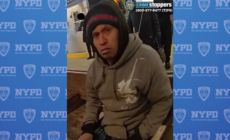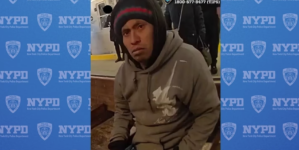-
How Airlines Pick the Movies on Your Flights - 12 mins ago
-
Two injured in crash of small plane on Carson golf course - 22 mins ago
-
Mets Could Lose $152 Million Pete Alonso To Dark Horse Rangers - 26 mins ago
-
Campus Groups Try to Make Room for Middle-Ground Opinions on the Middle East - 56 mins ago
-
Padres, Rays Fan Favorite Wil Myers Announces Sudden Retirement At 34 - about 1 hour ago
-
Suspect Caught After Setting Sleeping Woman Ablaze on NYC Subway - 2 hours ago
-
They Made Over $100,000 in Overtime. Now the N.Y.P.D. Is Cracking Down. - 2 hours ago
-
Bubba Wallace Reacts To Unexpected Support From Commanders’ QB Jayden Daniels - 2 hours ago
-
R.F.K. Jr. Wants to Overhaul the F.D.A. How Would Scientists Change It? - 2 hours ago
-
Alex Caruso Signs Blockbuster Extension to Stay with Thunder - 3 hours ago
Map of States with Highest Rates of Violence Against Women
Millions of women experience physical, sexual or emotional abuse at the hands of intimate partners each year. In 2024, certain U.S. states stand out for their particularly high rates of violence against women, spotlighting the ongoing challenges in addressing this widespread problem.
“Intimate partner violence is an extremely pervasive issue that impacts 1 in 3 women,” Katie Young Wildes, senior communications specialist, Women Against Abuse, told Newsweek. “In the United States, reported instances vary by state, municipality and ZIP code due to a plethora of factors.”
Data from the World Population Review (WPR) reveals the impact of violence against women, and Newsweek has compiled the data into a map.
A note on terminology: This article will make reference to the term violence against women to refer to sexual, physical and emotional abuse suffered by women, as is consistent with the study from WPR.

Jeenah Moon/Getty Images
According to the WPR, the states with the highest rates of violence against women are:
- Oklahoma
- Kentucky
- Missouri
- Nevada
- Alaska
In a statement shared with Newsweek, the Oklahoma Attorney General’s Office said the state is “plagued by violence against women,” and “it is crucial that we recognize its pervasiveness and what we can do to end it.”
The office noted that it hosts a statewide Partners for Change Conference annually and oversees the Oklahoma Domestic Violence Fatality Review Board. It added that, “During this year’s legislative session, a new fund was established to direct an additional $10 million in grants from the Attorney General’s Office to certified domestic violence and sexual assault providers statewide.”
What factors lead to higher rates of violence?
“Abuse happens in all communities and corners of the world; no geographic, cultural, educational, ethnic or religious cohort is immune from abuse,” Leslie Morgan Steiner told Newsweek. Steiner is the author of Crazy Love, which is “a memoir of love and violence.”
Steiner said that “Isolation, poverty, financial control, traditional sexism, lack of shelters and legal advice, and cultural pressure to ignore abuse create unique vulnerabilities for victims and immense barriers to leaving dangerous relationships.
“State-level domestic violence awareness training of police officers, district attorneys, the legal community, educators and family court judges have an enormously positive impact on victims and perpetrators. A low level of reported abuse can actually be a red flag, and a high level of reported abuse can be positive, because abuse is a vastly underreported and underprosecuted crime.”
A spokesperson for the Battered Women’s Justice Project (BWJP) told Newsweek: “It’s also important to scrutinize what is meant by ‘rates of domestic violence.’ Statistics based on crime and arrest data only tell part of the story and often inaccurately.”
Wildes emphasized that “this issue is vastly underreported. Perpetrators of relationship abuse will often threaten to hurt or even kill their partner if they reach out for help.”

ROBERTO SCHMIDT/Getty Images
The BWJP added: “Higher rates of VAW [violence against women] are due to a combination of social and economic conditions, levels of victim-centered system and community responses, and the lack of state commitment. This intersection of issues exacerbates sexism and misogyny, leading to higher rates of VAW.
“States with significant rural or hard-to-reach areas often present higher rates of domestic violence, sexual assault and human trafficking, as well as higher lethality rates. Isolation and lack of resources contribute to this.
“Law enforcement responses are critical to both the perceived and actual safety of domestic violence survivors.”
The BWJP added: “Social structures, such as gender norms, reinforce perpetrator behaviors and further entrap victim-survivors by limiting women’s employment and career advancement, and isolating them from support sources.”
Lisa Fontes, Ph.D., told Newsweek that poverty, gun control and law enforcement and how it varies across states as contributing factors in rates of violence against women.
An abuser who has easy access to a firearm is able to threaten and intimidate his victim, and this makes it much more difficult for her to leave safely,” Fontes said. Speaking about poverty, she said: “States that have inadequate poverty reduction programs are insufficiently supporting women’s safety.
“A swift and clear response from law enforcement that intimate partner and sexual violence will be punished sends a message to abusers that they must stop.”

Jeenah Moon/Getty Images
How can state-level policies help women?
The BWJP told Newsweek: “State-level policies must significantly increase the resources available for victims and offer a variety of responses to violence beyond the criminal legal system to meaningfully decrease gender-based violence.
“Policies should include exceptions to relocation restrictions in cases of domestic violence, prioritize safety in custody and parenting time decisions, protect reproductive rights, and provide legal representation for survivors. This includes free legal representation in areas directly related to safety and welfare, such as custody and housing, particularly in cases where parental rights are at risk of termination or custody is an issue.”
Fontes told Newsweek: “Seven states in the U.S. now have laws addressing Coercive Control. These are new, and in six of those states, those laws cover only family issues such as protective orders and child custody.” She said that she is “cautiously hopeful that these laws will offer additional protections to victims.
“State policies should discourage dual arrest. A dual arrest is where a police officer might come to a scene where a domestic abuse has been reported and arrest both parties.”
She cited Massachusetts as an example of somewhere this policy is in place. She said that if one person struck back in self-defense, they should not be arrested.
“It is crucial to offer interventions such as a crisis hotline, emergency shelter, safe housing and legal assistance,” Wildes said. “State-level policies and funding are essential to maintain a healthy safety net. When these resources do not exist or are depleted, victims are far less likely to escape from the abuse and rates of domestic violence will increase.”
Steiner said: “It is so critical for victims to break the silence and for bystanders to understand the prevalence of abuse. One in 3 women will be impacted by abuse in their lifetime, 15 million children are abused every year, and over 500 women and girls are killed annually by partners or former partners.”
For those seeking help, there are resources available, like the National Domestic Violence Hotline (1-800-799-SAFE).
Do you have a story Newsweek should be covering? Do you have any questions about this story? Contact LiveNews@newsweek.com.
Source link

















